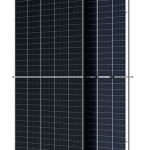The Duomax V and Tallmax V panels are equipped with glass-glass and glass-backsheet frames, respectively. Both offer a reported 21% efficiency and orders will be taken from the second quarter on. Trina plans to have a combined 5 GW of annual production capacity for the products this year.
The company intends to have 5 GW of annual production capacity in operation for the products this year.
Image: Trina Solar
ShareIcon FacebookIcon TwitterIcon LinkedInIcon Google PlusIcon WhatsAppIcon Email
Chinese panel maker Trina Solar has launched two new PERC monocrystalline bifacial solar modules, each with a reported power output of 500 W.
The Duomax V has a glass-glass structure and the Tallmax V features a glass-backsheet frame.
With Trina reporting a conversion efficiency of 21% for each product, the modules include ‘large-format’ 210mm silicon wafers and the manufacturer’s multi-busbar technology.
Trina claims to have created an innovative cell design combining advanced third-party devices, a non-destructive cutting process and high packing density. “This further reduces resistance losses, significantly improves the module resistance to cracks and hotspots and at the same time maximizes module efficiency,” said the company. “If the traditional half-cell design was applied to oversized silicon wafers [of] 210mm, the high output currents of the modules could pose a challenge for the system components and cracking could lead to the module breaking.”
Orders
The manufacturer added, compared to conventional 410 W bifacial modules, the Duomax V in particular can reduce balance of system costs for large scale PV projects 6-8% and the levelized cost of electricity generated by such facilities 3-4%.
The Chinese solar manufacturer said it will begin accepting orders for the modules in the second quarter. Production capacity for the modules is expected to reach 5 GW this year with output set to start in the third quarter.
Trina claimed a world record 23.22% conversion efficiency with a large-area version of its n-type, crystalline silicon, i-TOPCon (industrial tunnel-oxide-passivated contact) bifacial solar cell in November.







